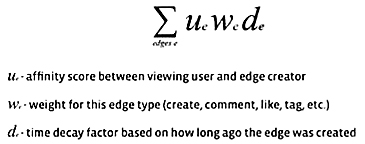Digital Influence Part One: Should I Even Care?
 Friday, May 20, 2011 at 10:11AM |
Friday, May 20, 2011 at 10:11AM |  Print Article |
Print Article | Yesterday I had a great discussion with a client about social, often known as 'digital' influence. Social influence is a huge buzz term within our industry right now, as it seems to be skyrocketing as importance to marketers that are seeking people to purchase and more importantly talk about their affinity with said product to their network of friends, fans and followers. These people are seen as pure platinum.
This phenomenon spans further than simply people too. Brands, celebrities and even topical trends have this digital influence. The foremost free players in measurement within the space:
- http://beta.klout.com
- http://www.peerindex.net
- http://twittergrader.com
- http://www.twitalyzer.com
- and admittedly http://www.empireavenue.com (a social game)
So what defines someone of digital or social influence? Well there are an array of factors, but the primary baselines are numbers of connections and activity within your networks. Well will talk in later posts about things that our peers find even more critical, but I will table that for today's discussion.
The question came within discussion of "why should my business even care what number I am?" And in a day and age of metrics, optimization and analytics it should be part of your overall self-assessment. You can look at your scores and determine if your digital reach, or amplification, is what you want it to be. This score can also be critical in determining if you have someone on staff that is in charge of social media, or community engagement that is being progressively monitored.
As a person, your social influence criteria can be two-fold. As a self analysis tool to your efforts in working within your network or a determinant key for business seeking people with perceived influence. As a marketer, I will often use a social influence ranking in seeking people for a blogger outreach program, or as a way to determine evangelist possibility for a brand.
It's REALLY important to remember that all of these things are not the measurement of a real person. You don't see many of our greatest minds on twitter talking about what they just ordered for brunch. Therefore these tools and a perception of influence as a whole, and should be looked at as a way to better harness attributes of the right kind of person. In fact, I will go further in saying that in many cases I totally disagree with this practice of ranking people, but it's a nessisary evil at times.
That being said the numbers do lie. People listen to their friends and trusted connections and they don't listen to advertisers anymore. So no matter what love/hate relationship I may have with social influence it will gain in popularity. And while many people still don't think that social media is a purely defined commodity, the same people will watch the news and comment on broadcast news metrics of the Presidential approval ratings. A very glorified social ranking, none the less.
Let's dive a bit deeper.
Wiki says:
"Social influence occurs when an individual's thoughts, feelings or actions are affected by other people. Social influence takes many forms and can be seen in conformity, socialization, peer pressure, obedience, leadership, persuasion, sales, and marketing. In 1958, Harvard psychologist, Herbert Kelman identified three broad varieties of social influence.[1]
- Compliance is when people appear to agree with others, but actually keep their dissenting opinions private.
- Identification is when people are influenced by someone who is liked and respected, such as a famous celebrity.
- Internalization is when people accept a belief or behavior and agree both publicly and privately."
Other's have written the equation like this:
- Brand awareness = Amplifier, Conversationalist
- Brand reputation =Opinion shaper, Conversationalist, Thought leader
- Word of mouth = Amplifier, Opinion shaper, Conversationalist
- Website traffic = Amplifier, Opinion shaper, Thought leader
Facebook has a ranking algorythim criteria for wall posts called "EdgeRank" which is like a micro in-app social influence ranking to see which article it pushes closest to the top of your feed wall and for how long.

Each Edge has three components important to Facebook’s algorithm:
- First, there’s an affinity score between the viewing user and the item’s creator — if you send your friend a lot of Facebook messages and check their profile often, then you’ll have a higher affinity score for that user than you would, say, an old acquaintance you haven’t spoken to in years.
- Second, there’s a weight given to each type of Edge. A comment probably has more importance than a Like, for example.
- And finally there’s the most obvious factor — time. The older an Edge is, the less important it becomes.
So what are your thoughts on digital influence? What can it tells us about? I'd love to hear your thoughts and please share this article with your social graph! Thank you.

Reader Comments